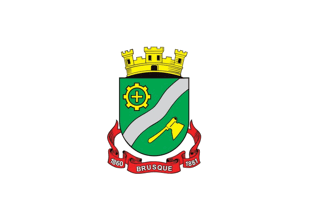 image by Ivan Sache, 1 November 2021
image by Ivan Sache, 1 November 2021
Last modified: 2021-12-11 by ian macdonald
Keywords: santa catarina | brusque | cogwheel | bend sinister | axe |
Links: FOTW homepage |
search |
disclaimer and copyright |
write us |
mirrors
 image by Ivan Sache, 1 November 2021
image by Ivan Sache, 1 November 2021
The municipality of Brusque (134,723 inhabitants in 2019; 28,344 ha) is
located 100 km north-west of Florianópolis.
Brusque was established in
1860 by 55 German colonists. On 25 July 1860, they sailed from Santa Catarina
island to Itajaí on the "Belmonte", a steamer that had served during the
Paraguayan War. Provincial Governor (1859-1861) Francisco Carlos de Araújo
Brusque (1822-1886), for which the town would be subsequently renamed, was
aboard, as well as Baron von Schneeburg (1799-1869), the Austrian director of
the colony.
The district of São Luiz Gonzaga was established within Itajaí by
Provincial Law No. 693 promulgated on 31 July 1873. The municipality of São Luiz
Gonzaga was established by Provincial Law No. 920 promulgated on 23 March 1881
and inaugurated on 8 July 1883. The municipality was renamed to Brusque by State
Decree No. 77 promulgated on 17 January 1890.
http://www.brusque.sc.gov.br/
Municipal website
Ivan Sache, 1 November 2021
The flag of Brusque is prescribed by Municipal Law No. 959 promulgated on 19
March 1981.
Article 1.
The new flag of the municipality of Brusque
shall be: A rectangular white field, charged in the center with the
municipality's official arms described in Article 3 of Municipal Law No. 156
promulgated on 22 December 1956.
Article 2.
The flag of the
municipality shall have modular dimensions proportional to those of the national
flag.
Article 9.
Law No. 350 promulgated on 29 July 1968 is abrogated.
https://leismunicipais.com.br/a/sc/b/brusque/lei-ordinaria/1981/96/959/lei-ordinaria-n-959-1981-institui-a-nova-bandeira-do-municipio-de-brusque-e-da-outras-providencias
Leis Municipais database
The abrogated Law, however, is labeled
'non-existent act, unused number".
https://leismunicipais.com.br/a/sc/b/brusque/lei-ordinaria/1968/35/350/lei-ordinaria-n-350-1968-ato-inexistente-numeracao-nao-utilizada
Leis Municipais database
The coat of arms of Brusque is prescribed by
Municipal Law No. 2,351 promulgated on 28 June 1999, which amended Aerticle 4 of
Municipal Law No. 156 (unavailable) promulgated on 22 December 1956.
Article 4.
The municipal coat of arms symbolized, through the restored
traditional Portuguese shield, the original national filiation, following the
most generalized style used in Brazilian municipal heraldry.
The green field
recalls the forest found by the early settlers, from 1860 onwards and even
earlier, on the banks of river Itajaí-Mirim, which is represented by a fess wavy
argent. Pioneer work by the first settlers and developers, first of them Vicente
Ferreira de Melo aka Vicente Só and by sawmills operated by Pedro José Werner,
Francisco Sallentien and Paulo Kellmer, as recalled by the first groups of
German, Polish and Italian established at the time, is represented by an axe or.
Finally, cloth industry founded by Carlos Renaux [1862-1945], as well as the
other industrial and social activities of his other firms, which were main
factors of progress and development for the municipality, are symbolized by a
cogwheel or placed on the green field, surmounting the pioneer's Christian
spirit and faith represented by a golden cross. Or and green emphasize labor and
force used for the common motherland, Brazil, and its golden and green flag.
On a red scroll representing love and enthusiasm for the motherland, the name of
the municipality in letters argent, and, to maintain the required homogeneity
with the shield, years "1860" and "1881", recalling 4 August 1860, the day
President of the Province Francisco Carlos de Araújo Brusque permitted the
establishment of the aforementioned German colonists, and 23 March 1881, the day
of establishment of the municipality of Brusque, as well as of the old colonies
emancipated from Itajaí, Brusque's original name, and Principe Dom Pedro, also
the root of the municipality of Novo Trento established in 1892.
https://leismunicipais.com.br/a/sc/b/brusque/lei-ordinaria/1999/236/2351/lei-ordinaria-n-2351-1999-altera-o-art-4-da-lei-n-156-de-22-12-56-que-instituiu-o-brasao-de-armas-do-municipio
Leis Municipais database
Photos
https://www.facebook.com/prefeituradebrusque/photos/a.2920128988061768/2920145434726790/?type=3&theater
https://www.facebook.com/prefeituradebrusque/photos/a.137847376289957/2885545241520143/?type=3&theater
https://www.facebook.com/prefeituradebrusque/photos/a.137847376289957/2232004053540935/?type=3&theater
https://www.facebook.com/prefeituradebrusque/photos/a.137847376289957/2168557143218960/?type=3&theater
https://www.facebook.com/prefeituradebrusque/photos/a.137847376289957/1966710250070318/?type=3&theater
 image by Ivan Sache, 1 November 2021
image by Ivan Sache, 1 November 2021
The flag of the Brusque Jeep Clube is blue with the club's emblem in the
center.
Photo
https://www.facebook.com/prefeituradebrusque/photos/a.2920128988061768/2920145434726790/?type=3&theater
[The two standard bearers are so lovely and take their role so seriously...]
Ivan Sache, 1 November 2021